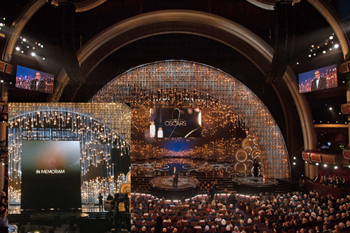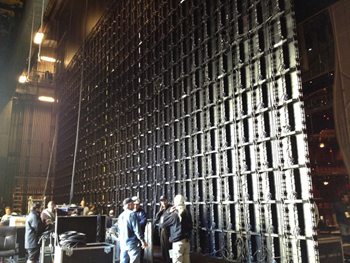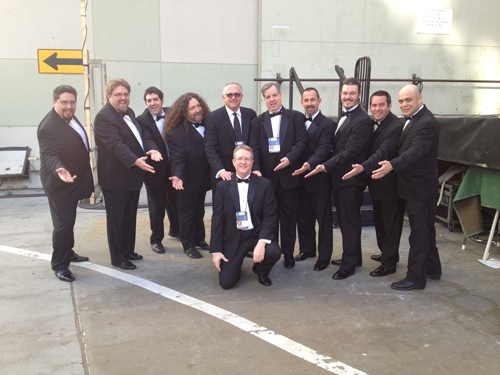Reinventing the Academy Awards

- The Oscars has always been one of the most interesting gigs you could land– after all, what better platform to demonstrate your technical chops than the most prestigious entertainment/technology awards ceremony there is? Over the years we’ve reported on the video technology used at the Academy Awards– and we’ve seen different mixes of video with traditional staging technology. We’ve seen the venue itself evolve its technology resources with the changing needs of the Oscar production as well as for other live event needs. This year’s Oscar ceremony saw brought some interesting twists to the narrative.
Two of the four “cube” LED modules above presenter Jack Nicholson’s head. Each was 11 wide X 13 ft tall– here butted for a 16X9 format screen. The full 4X array is shown in the inset photo. Note the two “house” IMAG screens at far left and far right in photo– these did not show up on TV coverage– with Christie projectors doing duty.
Since the venue previously known as the Kodak Theatre – with its 3,400 seats, the theatre has hosted the Oscars since 2002– was rebranded the Dolby Theatre in June 2012, the venue has hosted premieres for the Oscar-nominated films like "Brave" and "Zero Dark Thirty." It has also hosted Cirque du Soleil productions, and a wide variety of concerts. In preparation for the 2013 Oscars ceremony, Dolby came in and¬– working closely with this year's Academy Awards producers Craig Zadan and Neil Meron, Oscar telecast director Don Mischer, the film studios, and ABC– made sure everyone was on board for retooling the show to be broadcast in Dolby Surround 5.1, including every movie clip and taped segment. That included mounting 187 new loudspeakers in the theatre. In addition, new for this year, there was a new VIP lounge with a fabric ceiling designed to create the look of a sound wave, a 7.1 channel Surround Sound installation and a 84-inch flat panel display that showed a live feed of the Oscars broadcast. The process actually started last summer with the installation of a Dolby Atmos system, for the release of the movie “Brave” that was the first film to use the system (in fourteen theaters in the U.S. and Canada).
“Atmos, at any one time, can have 128 sound objects running,” said Dolby’s David Gray. “Pieces of sound can be placed anywhere in the room. Pieces of sound can be placed anywhere in the room. The Dolby Theatre has so many speakers–187– receiving so many commands, including, for some showings, an array that runs vaulted overhead–that it takes three processors to control them all.”

The Winvision 9 LED Cyclorama being completed during load in.
For the 85th Academy Awards ceremony, held Sunday, February 24th, at the Dolby Theatre, the buzz in the press was that the producers chose to go with a more traditional set design than in recent years. In its ongoing effort to retool the Oscars– always chasing new viewership– this year Tony Award-winning Production Designer Derek McLane was tasked to “add a fresh perspective to the set of the Dolby Theatre.” So would that translate to more live musical numbers, more theatrical lighting, etc, and less use of video projectors to ‘paint’ sets as we saw in some of the recent years’ productions?
Who reading this magazine could not have loved the trend that reached a peak at the Oscars in 2011, when many of the seventy-three projectors were used to “create sets,” i.e. digitally “paint” flown scenic elements, as opposed to just projecting film clips etc. In that 2011 production, the designers wrapped images to “make the set come to life.” The most impressive part of that was projecting onto four arched portals with rear-projected content framing the main stage, involving 40 Christie 10K HD projectors driven by an UberPan system of 40 outputs from twenty-two HD Hippotizers. That was the 2011 Oscars. The good news is that the same company that did that video production in 2011, Senovva, was involved in the 2013 production. And heading up SenovvA’s team: Oscar veteran Dave Taylor, Senovva’s Senior Technical Producer. While Senovva has been providing the projection (and LED) for the Oscars since 2005, Dave Taylor has twenty-four years experience working on the event. Taylor first did the projection for the event at the 61st Academy Awards, and he’s been on the job ever since (first, working with AVHQ, later with Creative Technology, and now with Senovva). But it was a somewhat different gig this year. Dave’s official credit this year was “Projection LED Supervisor”. LED? What about the video projection? This year’s production designers– in their attempt to get a more traditional, even Broadway, look and feel to the show, went a bit different direction. (But Taylor reminded me that there were other very LED-intensive years. “2005, 2006 and 2008 were all very LED-heavy years,” commented Taylor.)

The Video crew for the 2013 Oscars: L to R (standing): Freelancers Richard Larsen, Jim Agnor, Jeremy Hochman, and Scott Goegebuel; Frank McMinn, Principal Partner and President at Senovva; freelancers Scott Blair, and Joe Sebenius; Senovva’s Eric Leverton; freelancers Luke Frey, and Bill Starnes. Kneeling is Dave Taylor, Senior Technical Director at Senovva, getting the kudos for working his 24th Oscar show.
A daily selection of the top stories for AV integrators, resellers and consultants. Sign up below.
Projection lovers– hang in there, there was still enough interesting projection to go around at this year’s Oscars, despite the semantics of production credits (and in an era where the public is enamored with everything “LED”.)
Dave Taylor explained that LED, indeed, played probably its biggest role to date, in the Oscars show. And as you saw if you watched the telecast February 24th, while there was a good deal of video on the stage– it mainly was the old-fashioned kind in terms of content: IMAG, or film clips on screens. Anyone watching the telecast (or sitting in the Dolby Theatre) experienced, indeed, a more music-heavy, if not Broadway-style, production. Even before the many musical numbers kicked in, you could see the stage was more traditionally theatrical. Tony Award-winning Production Designer Derek McLane incorporated over 100,000 Swarovski crystals (weighing over 1,500 pounds) into the Oscar's stage design. More than a thousand (1,051) replica Oscar statuettes– each a little larger than the real award– was nestled in its own cubbyhole in traditional proscenium and could be lit separately or in sections as needed.
The set up consisted, first, of one big screen cyclorama, permanently upstage. It was 70 X 33 foot LED wall– a 9m Winvision 9, the same system Senovva used in 2012. The cyclorama used five hundred ninety-five Winvision 9.375mm LED tiles. For all the sets, there was a diffusion screen that stayed in place just 3/8 of an inch in front of the LED. This clever use of a diffusion screen served to eliminate the Moiré pattern you would get if you tried to video capture the screen without one. The diffusion screen also served to dampen down the lumen output of the LED. “Normally we’d run that kind of LED at about 12% intensity to balance with the other lighting etc,” said Taylor, “but with that diffusion screen–that has the effect of turning the LED into thousands of tiny video projectors projecting 3/8 inch out to that screen– we ran the LED at about 60% because the screen of course cut some lumen intensity.”

The “big picture screen”, used for Best Motion Picture nominee clips, and for the Governor’s award segment– were serviced b three Barco HDF-W26 projectors–on Stewart Videomatte 2000 screen was flown down.
Projection lovers will be pleased to know that there was one big projection screen– this year the crew and producers called it the “big picture screen” because it was used to screen the Best Motion Picture nominee clips, and for the Governor’s award segment– that did it with big guns. Three Barco HDF-W26 projectors– 26,000 lumens each– were stacked. One of them was a back up, while two were overlapped to get 50,000+ lumens on the screen. A Stewart Videomatte 2000 screen was flown down just in front of close down curtain (that shuts off upstage from down) four times during the show for this system.
Back to LED. The “cube” LED modules used a new product on the market. They are 3 millimeter format LED. Revolution Display 3mm or “RD3” is the name of a new product exclusive to VER. For the Oscars, the designers spec’ed in four LED “cubes”, and PRG supplied the automation for moving the cubes. For the “Captain Kirk” screen that flew in at the beginning of the show, two cubes– each was 11 wide X 13 ft tall– were butted for a 16X9 format screen. Later in the show, Barbara Streisand entered through all four cubes center stage–when she emerged, the two “wagons” tracked off to the wings, and the other stayed on stage for her rendition of “The Way We Were” in the Marvin Hamlisch tribute segment.
And if you loved all that use of video projection to “paint sets” in the 2011 and other Oscar shows, you no doubt loved the “Wavy Walls” in this year’s production. In act 2, and again in act 13, four Barco projectors were used to track four S-shaped walls. One wall was downstage, one upstage. The automation data was fed into a Hippo (just like in the 2011 production; Jason Rudolph was the show's Hippotizer programmer). And for the James Bond 50the Anniversary tribute those same projectors were used to project onto the “Bond discs” on set, as the Bond footage played on the big LED cyclorama.

For the second consecutive year Clay Paky Sharpys (distributed by A.C.T Lighting) made an appearance at the Oscars. A dozen chrome-plated Sharpy fixtures backlit Shirley Bassey in this set, the singer who over the years performed more Bond themes than any other singer, as she sang the “Goldfinger” theme. Bob Dickinson was the lighting designer for the Oscar ceremony. Downstage you can see the cyclorama (showing a diffused circle pattern)– a 70 X 33 foot 9m Winvision 9LED wall.Given the Academy of Motion Picture Arts and Science’s purported new focus on retooling the now officially retitled “Oscars” ceremony to create a more Grammies-like fast-paced show not a stodgy “Awards Ceremony”, it’s hard to predict how much envelope-pushing new video technology will be brought to bear for the 2014 Oscars. I’ll bet Dave Taylor and team at Senovva, PRG, and the Hippo folks will be involved. We’ll wait and see what Dave Taylor’s title for the show is next year.
